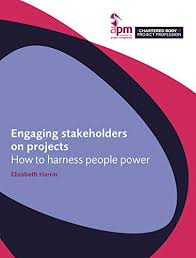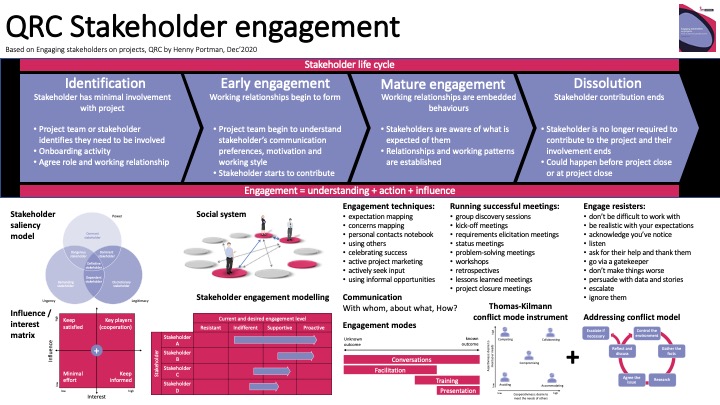
The book Engaging stakeholders on projects – How to harness people power, written by Elizabeth Harrin is the starting point if you want to get a better understanding of stakeholder engagement and it gives you a lot of practical advice, tips for improving practice key takeaways and action steps for successful stakeholder engagement.
The book starts with an introduction of the topic by explaining that you can’t manage your stakeholders, you can’t manage stakeholder’s behaviour and actions, but you can engage them. Stakeholder engagement is the systematic identification, analysis, planning and implementation of actions designed to influence stakeholders.
In the stakeholder life cycle you see the following four steps: identification, early engagement, mature engagement and dissolution.
The first chapter focusses on stakeholder identification. You can use a workshop to create a stakeholder list or start with stakeholder segments and you can ask already known stakeholders who must be involved too. Not all stakeholders are equal. Who are your primary, secondary, interested and hidden stakeholders? Next you must get clarity on stakeholder involvement. You can talk to them directly or ask colleagues about other stakeholders. You can use a stakeholder saliency model to understand who your definitive, dangerous, dominant and dependent stakeholders are, based on legitimacy, power and urgency measures for each of your stakeholders. You can also build an influence/interest grid to understand who of your stakeholders must be fully engaged, keep informed about progress, asked for input and identify their concerns and last a group who must informed from time to time. Be aware that stakeholder influence, interest and power are transitory and only as relevant as the day it was produced and that you must keep your analysis confidential.
The following chapter brings your stakeholder analysis to the next level. It gives you the instruments to understand how the social system works in your organization. A social system is the network of relationships and how they interact and influence each other as a whole. To understand the social system for your project you can review the team structure (functional, weak matrix, matrix or strong matrix and the project structure), use your network, talk to stakeholders or think strategically. Next you have to model your stakeholder engagement by plotting your stakeholders’ current and desired engagement level (resistant, indifferent, supportive and proactive). Besides the stakeholders influencing your project, you have to understand the organizational influences (or constraints) like policies, processes, procedures, standards, et cetera.
Now you know your stakeholders and how they interact and influence each other it’s time to engage them.
Engagement = understanding + action + influence
You have to understand the stakeholder’s perspectives. How do they feel about the project and the effect it will have on them (emotional appeal) and how confident they feel that the work being done is the right work (rational appeal)? Next you have to build credible, trusted relationships otherwise you can’t influence them. There are two things that you should be engaging your project stakeholders throughout the project life cycle in: the project deliverables (purpose, why) and the project management process (what, roles, responsibilities). Engagement can be formal or informal by using on or more engagement techniques, e.g., expectation mapping, concerns mapping, personal contacts notebook, using others, celebrating success, active project marketing and actively seek input and using informal opportunities. A large element of engagement is communicating with the right people at the right time, in the right level of detail and with a specific goal in mind to help them take action. Communication can be conversations, facilitation, training or presentations. Special attention has been given how to make the best of your relationship with your project sponsor, and engagement in a crisis.
The following chapter looks at techniques for running efficient meetings and facilitation. How can you work with groups in a collaborative way to create energy and make it easy for the group to solve problems? To get the best results from a meeting with full preparation beforehand, strong leadership during the meeting and a professional follow up.
Projects and programmes change things. And not everyone embraces change. How can you identify resistance to engagement and engage resisters? Don’t be difficult to work with, you have to be realistic with your expectations, acknowledge you’ve notice, listen, ask for their help and thank them. If needed go via a gatekeeper, don’t make things worse and persuade with data and stories. And sometimes escalate to your project sponsor or ignore them (but use with care). Disengaged stakeholders present project risk so you have to identify and act on resistance.
What causes conflict on projects, how can you spot it and how can you resolve them? Conflicts can be found during project kick off, project planning, project delivery and/or project closure. The Thomas-Kilmann conflict mode instrument is a common model for considering approaches to dealing with conflict (avoiding, accommodating, competing, collaboration and compromising). A basic process for addressing conflict breaks down in the following steps: pick the location and environment, gather the facts, research and recognize stakeholder power and personal views, meet and agree on the issue, reflect and discuss and, if necessary, escalate.
The last part of the book is a deeper dive into interpersonal and technical skills and behaviours that are beneficial to stakeholder engagement. Besides the already extensively discussed communication and conflict resolution we get insights and tips in the following areas: negotiation, influencing, listening, business acumen, resilience, credibility, assertiveness, contextual, cultural and ethical awareness.
Conclusion
The book is easy to read and it’s a valuable aid to get a good understanding of stakeholder engagement in line with the APM Body of Knowledge 7th edition. The book gives you a lot of practical advice, tools, tips for improving practice, key takeaways and action steps for successful stakeholder engagement. I would say a must read for project, programme and portfolio managers.
To order Engaging stakeholders on projects: Amazon.com























